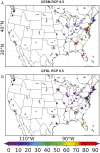The motley drivers of heat and cold exposure in 21st century US cities
- PMID: 32817528
- PMCID: PMC7474622
- DOI: 10.1073/pnas.2005492117
The motley drivers of heat and cold exposure in 21st century US cities
Abstract
We use a suite of decadal-length regional climate simulations to quantify potential changes in population-weighted heat and cold exposure in 47 US metropolitan regions during the 21st century. Our results show that population-weighted exposure to locally defined extreme heat (i.e., "population heat exposure") would increase by a factor of 12.7-29.5 under a high-intensity greenhouse gas (GHG) emissions and urban development pathway. Additionally, end-of-century population cold exposure is projected to rise by a factor of 1.3-2.2, relative to start-of-century population cold exposure. We identify specific metropolitan regions in which population heat exposure would increase most markedly and characterize the relative significance of various drivers responsible for this increase. The largest absolute changes in population heat exposure during the 21st century are projected to occur in major US metropolitan regions like New York City (NY), Los Angeles (CA), Atlanta (GA), and Washington DC. The largest relative changes in population heat exposure (i.e., changes relative to start-of-century) are projected to occur in rapidly growing cities across the US Sunbelt, for example Orlando (FL), Austin (TX), Miami (FL), and Atlanta. The surge in population heat exposure across the Sunbelt is driven by concurrent GHG-induced warming and population growth which, in tandem, could strongly compound population heat exposure. Our simulations provide initial guidance to inform the prioritization of urban climate adaptation measures and policy.
Keywords: climate adaptation; climate change; cold exposure; heat exposure; urban climate.
Conflict of interest statement
The authors declare no competing interest.
Figures





References
-
- Wu J., Urban ecology and sustainability: The state-of-the-science and future directions. Landsc. Urban Plan. 125, 209–221 (2014).
-
- Middel A., Krayenhoff E. S., Micrometeorological determinants of pedestrian thermal exposure during record-breaking heat in Tempe, Arizona: Introducing the MaRTy observational platform. Sci. Total Environ. 687, 137–151 (2019). - PubMed
-
- Myers S. S., Planetary health: Protecting human health on a rapidly changing planet. Lancet 390, 2860–2868 (2018). - PubMed
Publication types
LinkOut - more resources
Full Text Sources

